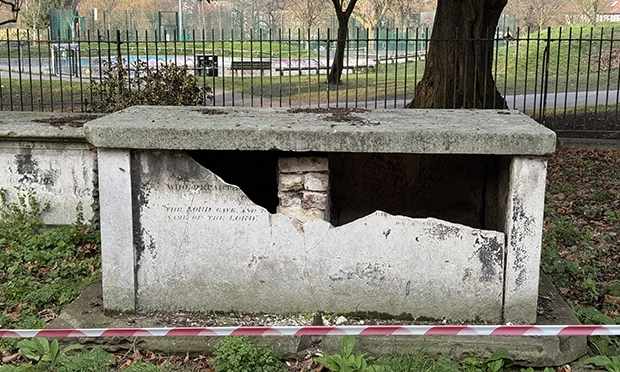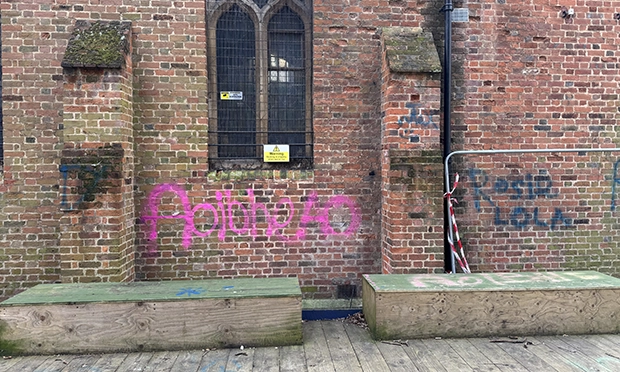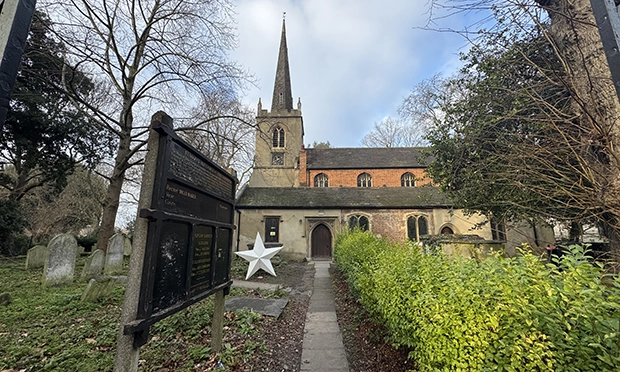‘Heritage crime’: Residents decry vandalism and decay at Old St Mary’s churchyard

A broken crypt. Photograph: Josef Steen / free for use by LDRS partners
Hackney Council is stepping in to fix a historic churchyard in Stoke Newington following “heritage crime” and disrepair.
Broken crypts, wild overgrowth, graffiti and wall damage at Old St Mary’s Churchyard were brought to the attention of Mayor Caroline Woodley in December when resident Vicki Fox demanded action over its “parlous state”.
“Apart from anything else, surely it must be the only 16th-century church, unique within inner London, in what was once a village?” she told the Citizen.
“I appreciate that Hackney is poor in resources, but [it is] rich in history.”
Fox, 84, who has lived in the borough for more than 60 years, also contacted Historic England, who judged that while the Grade-II listed building and its adjacent memorial field had not been neglected, the vandalism to the graves and the building was “heritage crime”.
The burial ground is the resting place for “distinguished” late-18th century individuals, including the poet and essayist Anna Laetitia Barbauld.

Graffiti on the building’s wall. Photograph: Josef Steen / free for use by LDRS partners
In her letter to the mayor, Fox lamented that due to the churchyard being allowed to become so overgrown with ivy and elder, several tomb inscriptions had been “obliterated”.
Mayor Woodley said: “Heritage green spaces, like Old St Mary’s Churchyard, are an important part of Hackney’s rich history and green infrastructure.
“We understand residents’ concerns about vandalism and disrepair at the site and are working alongside partners to make sure the grounds are maintained in a step-by-step way that will preserve their heritage.
“We are working closely with specialists to carry out some careful conservation and repair work, while ensuring no unnecessary damage is caused. This includes specialist approaches to managing vegetation growth, removing ivy from memorials and repairing the churchyard walls.”
Both the church and churchyard are a relic of the parish of Stoke Newington, mentioned in the Domesday book — a manuscript record of the Great Survey of much of England and parts of Wales which was completed in 1086 by command of William the Conqueror.
The medieval building in its current form was completed in 1563, but a church on its site is thought to have stood since the 14th century.
It was replaced in 1858 by the gothic St Mary’s across the road, and now functions as the arts and music venue, The Old Church.

The Grade II-listed church. Photograph: Josef Steen / free for use by LDRS partners
According to the map-based history website Layers of London, Old St Mary’s is the “only surviving Elizabethan church” in the capital.
While the council is in charge of maintaining the burial ground, the Diocese of London is responsible for the structure itself.
A spokesperson for the Diocese told the Citizen: “Old St Mary’s is a truly unique and much-loved focal point of the Stoke Newington community, and has been for hundreds of years.
“We’re proud of the way residents have continued to support the church through its live music and events programme, but we recognise that the churchyard is in need of urgent repair.
“We are working closely with the council to ensure that it carries out repairs and improvements as soon as possible to ensure this historic church is given the care it deserves, [so] it can continue to be a part of the Stoke Newington landscape for many years to come.”
Fears have abounded around the fate of listed churches amid speculation over whether Chancellor Rachel Reeves will soon bring an end to a tax exemption scheme designed to cover the costs of restoration work over £1,000.
First introduced under New Labour, the Listed Places of Worship (LPW) Grant Scheme is due to expire in March this year.
No mention was made of it in the Chancellor’s Autumn Budget last year, sparking concern among religious organisations that it would not be renewed.
The National Churches Trust said there was “no doubt that this would tip many buildings and community activities that would otherwise continue into closure”.
